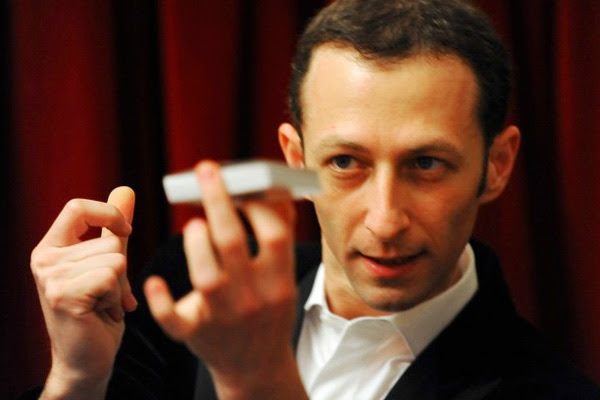How To Design a Magical Life
 (Photo: Alexandre17/shutterstock.com)
(Photo: Alexandre17/shutterstock.com)
You know those magical moments when fates collide, uncertainties resolve into sudden, stunning clarity, and the resulting awe and gratitude you feel for the benevolent and wondrous universe can hardly be described in mere words?
It’s Ferdinando Buscema’s job to design moments like that.
Buscema is a “Magic Experience Designer”—a profession that won’t be appearing as a result in a career aptitude quiz any time soon. As the job title suggests, Buscema devotes himself to creating magical experiences, both in daily life and for the corporate clients who hire him to add an element of awe to their training days and corporate retreats. Drawing on a background that combines mechanical engineering, humanistic psychology and hermetic traditions, Buscema brings magic to people’s lives, both as a performer on stage, and in more surreptitious ways.
When designing a magical experience, Buscema says his aim is to “create a space where people can transcend their idea of ‘normal’ and experience wonder.” For adults, this can be tricky. An openness to awe, according to Buscema, is something we are born with and carry as children, but tend to lose touch with as we age, the world becomes more familiar, and we are overwhelmed with information.
“Grown-ups need a trigger of sorts to activate, or to re-enter, this primal state of wonder,” he says. Magic, deftly deployed, can provide that trigger. And by following Buscema’s lead, you can create magical experiences, for yourself and those around you, every day.
Revise your definition of magic
In many cases, magic as performed on TV or on stage is ”the ego show of the egomaniac magician,” says Buscema. “It’s, ‘Look at me, how cool I am, because I can do things that you cannot fathom!’”

Ferdinando Buscema.
Such a message, says Buscema, is not empowering to the viewer. As a magic experience designer, his aim is “to make magical things happen in day-to-day life, outside of a theatrical context.” Though he does sometimes jump on stage to do card tricks for corporate clients, the performance is just one component of the immersive experiences he designs. Stunts and tricks, sparingly used, can help solidify a concept and empower those who feel its awe to seek out their own magical experiences.
“It’s almost like a kind of zen meditation: finding ways to trigger magical moments in everyday life,” says Buscema. “The world is already filled with wonder; my job is to attract your attention to it.”
Get comfortable with uncertainty
We live in an age of overabundant information in which uncertainty has become the enemy. When a question arises, the answer is a mere Google search away.
This state of affairs doesn’t leave a lot of room for mystery. But the “not-knowing zone,” as Buscema describes it, is just where you want to be if you want to experience magic.
In 1817, the Romantic poet John Keats coined the phrase “negative capability” to describe, in the words of Stephen Hebron at the British Library, “the idea that a person’s potential can be defined by what he or she does not possess–in this case a need to be clever, a determination to work everything out.” Someone who has negative capability, wrote Keats in an 1817 letter, “is capable of being in uncertainties, mysteries, doubts, without any irritable reaching after fact and reason.”
It can be difficult to resist researching everything when the information is just a few iPhone touchscreen taps away. But if you allow yourself to remain in a state of uncertainty, says Buscema, there develops “a tension between the moment you know you do not know something, and the moment you do know something.” This liminal state is the perfect foundation for removing rationality and inducing awe.
Use trickery for good, not evil
Trickery and deception are integral parts of magic, but they don’t need to be employed in a mean-spirited way that makes people feel foolish. “The goal of magic is not to fool people,” says Buscema. “The goal of magic is to stimulate people to live life in a state of wonder.”
Buscema shies away from magic that victimizes or ridicules—not just because it’s mean, but because it’s lazy. “Dropping a bucket of water on someone’s head and laughing at them is too easy,” he says. The greater challenge is to find ways to prank people in a way that is ultimately uplifting.

Participants in Improv Everywhere’s No Pants Subway Ride, adding wonder and intrigue to the daily commute. (Photo: Oh Barcelona/flickr)
In his book Amaze, co-authored with frequent collaborator and self-professed “Wonder Injector” Mariano Tomatis, Buscema cites the example of a 2005 stunt called Romantic Comedy Cab, staged by New York-based prank collective Improv Everywhere. The mission involved a man named Anthony hailing a cab and telling the driver he was trying to find a woman, Kate, he had met and fallen for the previous evening.
Anthony described how he had written down Kate’s number and the name of the restaurant where they had planned to meet on a napkin, but had lost the napkin. Anthony told the cab driver he had been walking around all night trying to find the restaurant, and couldn’t bear the idea of Kate thinking she’d been stood up.
The cab driver commiserated, dropped Anthony off at a bar, and wished him luck. Later that evening, another Improv Everywhere agent got into the same cab and told the driver about how she had met an amazing man the night before, but he had failed to arrive at their scheduled date. She was Kate. The cab driver realized the connection, drove Kate to the bar where he’d dropped off Anthony, and the two reunited with much excitement and hugging.
You could call that a trick or a prank. But the mission of Romantic Comedy Cab, and the aim of all Improv Everywhere’s stunts, is not to humiliate or ridicule. It is to engender awe by creating “scenes of chaos and joy in public places.” Sure, there is deception involved. But the deception is a necessary precursor for ultimate delight.
 (Photo: Tom Roeleveld/flickr)
(Photo: Tom Roeleveld/flickr)
Writing in Amaze, Buscema and Tomatis mention a fascinating postscript to the cab story:
Reuniting the two lovers in New York, the cab driver with the African accent did not know he had been part of a fiction and sincerely felt to have contributed to the triumph of love between Anthony and Kate. Was he just deluding himself? Maybe not: on August 23rd, 2008, in fact, the two lovers got married. Such an image is the perfect symbol of what strikes us the most about magical experiences: their ability to transcend fiction and become true.
Use kindness to inspire wonder
“At the core of a random act of kindness is pure magic,” says Buscema. “Every time it happens, a moment of wonder is unleashed.”
Lately, Buscema has been conducting some magical experiments in mall parking lots. He’ll take a 50 Euro bill and place it, along with a handwritten note, under the windshield wiper of a random, humble-looking car. (“The flavor of the note,” says Buscema, “is like: ‘Someone is caring for you; you have a hidden support.’”)
Note placed, he waits. Invariably, when the driver returns, their reaction is to be suspicious, then astounded, at the discovery of the anonymous gift.
“You can make someone’s day with even $10,” says Buscema. “But it’s not the amount of money that gets the job done—it’s the message.”

(Photo: airart/shutterstock.com)
Such benevolent acts don’t fit within the standard, showy realm of “magic,” but their effect can be profound on both the recipient of the gift and the person who plants it.
“To some extent you’re sacrificing your ego,” says Buscema, but though it may come in a different form, the reward is still there. When he commits random acts of kindness, he is “creating an experience that will keep people’s minds spinning for some time, I like to think, in a fertile way. And that’s how I play my game.”










Follow us on Twitter to get the latest on the world's hidden wonders.
Like us on Facebook to get the latest on the world's hidden wonders.
Follow us on Twitter Like us on Facebook